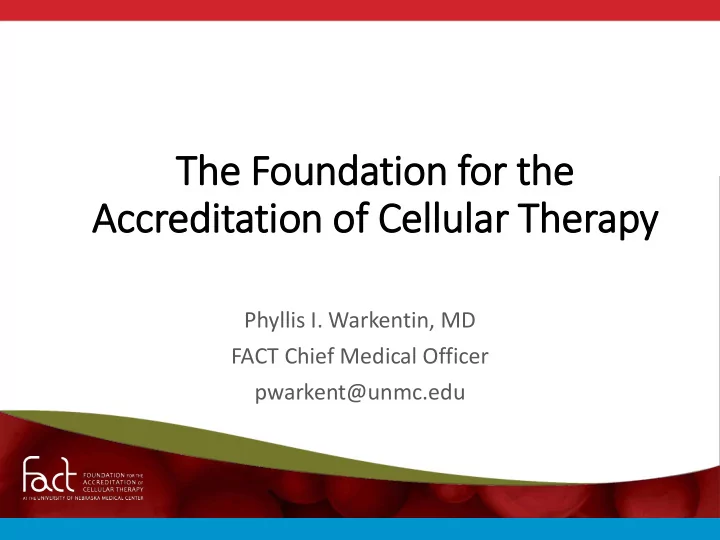

The Foundation for the Accreditatio ion of Cell llular Therapy Phyllis I. Warkentin, MD FACT Chief Medical Officer pwarkent@unmc.edu
FACT’S Role in Cellular Therapy • MISSION: to improve the quality of cellular therapies through peer- developed standards, education, and voluntary accreditation • Promote quality patient care and laboratory practice A valid accreditation process for HPC transplantation must include assessment of clinical practice, cell collection, and laboratory services • Improve treatment outcomes • Foster research and continued development of cellular therapies • Standards and Accreditation arm of • American Society for Blood and Marrow Transplantation (ASBMT) • International Society for Cellular Therapy (ISCT) • International NetCord Foundation (NetCord)
Evidence-Based Standards • Developed / revised by consensus of experts in the field (clinicians, laboratory scientists, technologists, nurses, quality managers, pharmacists, others) • Input from regulatory bodies, legal, professional organizations, public • Current publications: • FACT-JACIE International Standards for HEMATOPOIETIC CELLULAR THERAPY Product Collection, Processing, and Administration – 6 th Ed. • NetCord-FACT International Standards for CORD BLOOD Collection, Banking, and Release for Administration – 6 th Ed. • FACT Common Standards for CELLULAR THERAPIES – 1 st Ed.
FACT’s Accreditation Program • Voluntary; peer-driven; international • Focused on improving patient outcomes; demonstrated improvements published • Hematopoietic Cell Transplantation Programs • 221 Facilities accredited in 6 countries • Includes 181 Clinical Programs • 30 Processing Facilities accredited for “more than minimal manipulation” – includes cancer trials, immunotherapy trials, INDs • Cord Blood Banks: • 56 Banks in 23 countries; unrelated and related donations • 8 HRSA-funded Cord Blood Banks
FACT Common Standards for Cellular Therapies • Developed in response to rapid advances of cellular therapies into clinical trials; wide variety in quality • Based on current HPC and CBB Standards • Applicable to any cell type, cell source, clinical application; phase of development or clinical trial • Requirements: quality management; process controls for facilities, personnel, equipment, procedures, testing, labeling, transport • Outcome measures primarily safety • Basis for voluntary, primary accreditation / certification in early phase products or applications • Basis for additional discipline-specific or product-specific standards in collaboration with relevant experts
FACT Standards for Immune Effector Cellular Therapies • Developed in response to numerous clinical trials with limited manufacturing sites, diverse clinical settings • Products may be associated with unique/significant toxicities • Based upon FACT Common Standards – applicable to clinical units outside of traditional transplant units • Standards unique to immune effector cells will be added to Hematopoietic Cell Standards, applicable to accredited transplant facilities
Cardiovascular Medicine Standards • Importance of collaboration with experts • Cardiovascular Cell Therapy Research Network (CCTRN; www.cctrn.org) • Network of physicians, scientists, and staff dedicated to research studies of stem cell therapy in the treatment of heart disease, with the goal of more effective treatments for patients with cardiovascular disease • Collaboration to develop cardiac-specific additions to Common Standards toward goal of accreditation in cardiovascular medicine, inclusive of clinical and laboratory aspects.
Comments to Draft Guidances • FDA should fulfill responsibilities to protect patients in search of cellular therapies; support to ISCT in its position on unproven therapies; provide education • Development of professional standards and voluntary accreditation can play an important role • Precedent noted in “Same Surgical Procedure Exception…” “…hospitals must follow the guidelines of the Joint Commission on Accreditation of Healthcare Organizations (JCAHO) for tissue storage…” • Experts in respective fields who hold themselves to a higher standard are in best position to maintain quality, safety; collect appropriate data, and complete clinical trials • Urge development of mechanisms to reduce the burden of clinical trials to get promising therapies to patients: • Examples: shared validation studies for microbial testing; use of accredited clinical sites for early clinical trials
Comments to Draft Guidances • Tiered unified approach to HCT/P regulation fails to acknowledge the complexity of some tissues with multiple native functions, many cell types; difficult to strictly categorize complex tissues (such as adipose tissue) as only structural or cellular. Possible solutions: • Determination of “homologous use” not depend on initial categorization of the whole tissue, but allow for cells and structural elements to be considered individually. “Such HCT/P” either the cells or the structural elements, depending on intended use. • Broaden term homologous use to include any function or functions performed in the donor, not only the “basic function” • Recognize “standard of care” exemptions for certain procedures that have long been in place without such tissue regulation; data exist related to practitioners, procedures, and safety.
Comments to Draft Guidances • Some inconsistencies: • Definition of homologous use: “perform the same basic function or functions” “perform one or more of the same basic functions” Examples seem to ignore the concept of more than one function of a tissue • Non-homologous to put adipose tissue in breast (breast function is lactation, ignoring role of fat in support and shape); but homologous to put islets in liver (liver function is not glucose homeostasis)
Additional suggestions • Expand expectations for cord tissue, to include which regulations apply and when they apply: • Examples: • Whole cord tissue, collected, cryopreserved and stored as whole tissue. Future use undetermined at collection, but likely for patient treatment. • Cord tissue processed first, then cryopreserved and stored with intent to use as MSCs or other product. • International harmonization is important to facilitate product development and world-wide availability of cell- based therapies for patients.
Resources: Website: www.factwebsite.org Quality Handbook: www.factwebsite.org > Store Quality Management Series: www.factwebsite.org> Education and Resources > Quality Management Series Allied Learning Center: www.factwebsite.org> Education and Resources > Allied Learning Center Thank You
Recommend
More recommend